#Baikal Nomads
Explore tagged Tumblr posts
Audio
(Baikal Nomads)
0 notes
Text
Digital nomads - Legolas x Reader
Content & Warnings: Modern AU, drabble Word count: 0.8k Summary: You and Legolas travel the world together staying in different countries for a few weeks or months before moving on, posting traveling content and some awesome archery trick shots.
A/n: definetely brought to you with the help of 'Migration Feathers' by General Elektriks

Your blog reaches 100k subscribers when you upload the final part of the series about your trip to Cambodia – the first one out of Europe that you take with Legolas. He is so emotional about the milestone, that even your joy seems to be but a faint reflection. His genuine delight brings back the memories of your first journey together. He was smiling just as brightly when you brought him to the best places you knew in the Netherlands and filmed his honest reaction to seeing deers in De Hoge Veluwe.
______________________________________________________________
As the hiking trail takes you two to Himakånå, the view from the cliff just isn't as breathtaking as the man before you. Standing high above the lake with wind catching in his hair he seems to be some ethereal spirit of the place. Eyes as blue as the water below. Faint shade of pink dusting his face after a long climb uphill. Life paints him so vividly, that you only take a few pictures, mostly staring shamelessly.
The following week you come back with a costume and a bow, accompanied by a mutual friend, Gimli. Despite the initial grumpiness and some rough jokes he takes great interest in showing you around the best sceneries in Tysvær and cheers for the best shots like a whole supporting team.
In the completed outfit Legolas seems like an elven prince rather than a son of some big shot in law. There's a translucent fog catching on the grass under his feet, making him appear all the more mystical and dreamlike. He doesn't say it out loud, but you notice from the look in his eyes that he feels relieved not being bound to the past in one more way. As much of an escapism as it is, you respect that.
Videos and photos from the hike take up a solid half of your SD card memory and two good days of editing before they hit your blog. Once they do though – the chaos ensues. Numbers on posts double within a day, while the portraits of your boyfriend begin their grand parade around the internet. You almost feel jealous. Legolas smirks proudly, but blushes so deeply, that you can't help a smirk as well.
______________________________________________________________
When Legolas walks onto the meter-thick ice of the lake, you finally know what to compare his eye color with. Between the bottomless sky and frozen water, seemingly the only person for miles around, except for you and the guide, he looks like a deity walking through the clouds of crispy snow. He turns back at you with those magnificent azure orbs framed with frosted lashes, and a blissful wave of warmth washes over you instantly in spite of the biting cold air. Legolas has that incredible ability to share his amazement, which attracted you to him in the first place.
He strides over the smooth icy surface confidently, like he was born in one of the villages on the eastern shore, crosses the major crack in one long jump over the exposed waters of Baikal and looks up to the crystal sky, all but dedicating poems to it. The bow in his hand only adding to the romantic image. The local guide, walking beside you, watches him with a smirk and says. «If Abai Geser had come from the West, that would be him.»
______________________________________________________________
When you get from one neat bar to another, tasting cocktails – sweet, bitter and even spicy on your tongues – and mixing the flavors even more through dozens of kisses, getting rowdy on the way until dropping at some karaoke, your blog hits half a million. Legolas starts a live stream right there in the cramped little room somewhere in Seoul mere minutes before sunrise.
He talks enthusiastically to the gathering viewers, while you half-hidden behind his back get the first row seat to the show. He is flushed from the alcohol and so carefree, easily falling into the quick speech pace chattering about your Asian trip and further plans. Such a striking contrast to the uptight college boy he was when you first crossed paths.
The thought of the past two years brings a smile to your lips, curling the edges slightly. Legolas somehow takes notice even through the small image on the phone screen and turns to you, only to be greeted with a passionate kiss and fingers readily finding their way to his ruffled hair. «I love you. More than anything or anyone. You're my home and my freedom,» you whisper heatedly to his ear.
Your eyes dart to the still working front camera of his phone, narrowing slightly before you turn the thing off completely. To hell that live stream, the viewers and whoever else. Let them think and overthink your actions as long as they wish. You two are now together and that means you are free from any boundaries and expectations.
30 notes
·
View notes
Text

Title
Siberia’s Shamanism
ATHANASIOS MALOUKOS
Greece
A Buryatian shaman performs a ritual to connect with the spirits, on frozen Lake Baikal, with the sacred Ogoi cape in the background. Lake Baikal is considered the most sacred place of Siberia’s shamanism.
The origins of shamanism can be traced back to the ancient nomadic cultures of Central Asia and especially Siberia, where shamanism was a prevalent form of spiritual practice.
A shaman serves as a healer, problem solver, protector from hostile spirits, a guide and a medium between the spiritual and human worlds.
Neutral Density Photography Awards 2023
#athanasios maloukos#photographer#greece#siberia#buryatian shaman#shaman#siberia's shaman#lake baikal#russia#ogoi cape#neutral density photography awards#culture
10 notes
·
View notes
Text
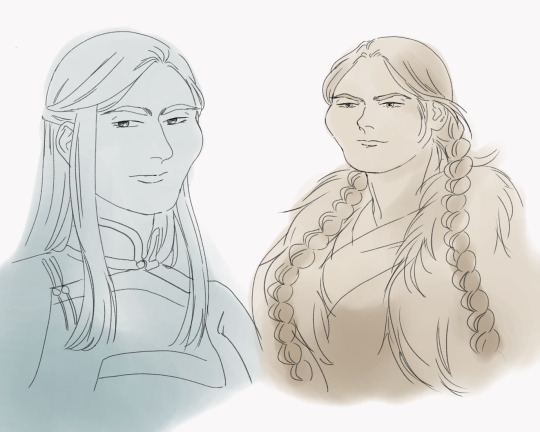
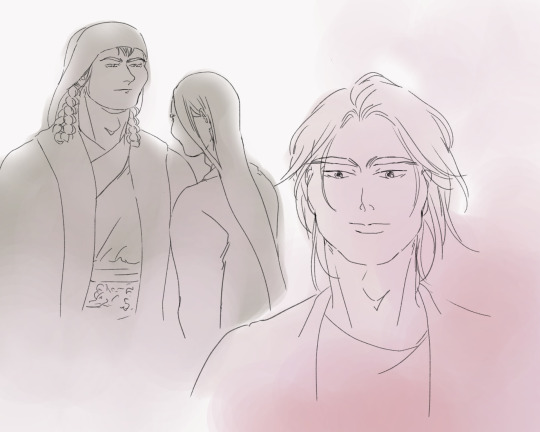
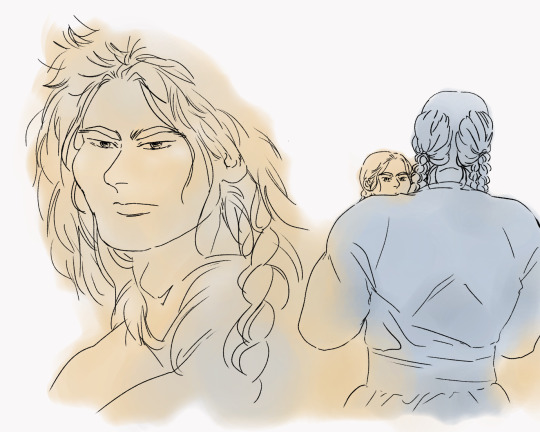
1) Buryatia + nyo!Mongolia
2) Kyrgyzstan + Mongolia and (Yenisei) Kyrgyz
After its establishment, Mongol Empire quickly subjugated Turkic confederations and groups in the territory of Mongolia and around the Baikal such as Kerait, Naiman, Merkit, Tatar, and Yenisei Kyrgyz (though Merkit was probably Mongolic). All these Turkics were Mongolia’s first harem. In the end, only the Kyrgyz would survive as distinct people into the current time as most of them became modern Kyrgyz people in Kyrgyzstan. The others were quickly absorbed into Mongolians or Kazakh.
It’s unknown whether Kyrgyzstan is the former Yenisei Kyrgyz or if he is a successor who carries the latter’s memories, but Mongolia feels familiar with Kyrgyzstan beyond what he would feel about a country who happens to share a similar nomadic culture. As it stands, today’s Kyrgyzstan looks different from the mostly West Eurasian Yenisei Kyrgyz, but Mongolia almost swears they’re the same person. Mongolia could also differentiate easily between Kazakhstan and Kyrgyzstan even when many others aren’t able to (“How are you not able to distinguish them? They’re massively different!” Says Mongolia)
(I gave Yenisei Kyrgyz Göktürk era clothing as I haven’t found their specific costume, lol)
3) Golden Horde + baby Golden Horde carried by Mongolia
When Golden Horde was newly born, he was close to Mongolia who would often carry him everywhere (or let his horse do the job). Think of a toddler who stares unblinkingly at you from underneath all the fur wrapped around his tiny body as if trying to drill a hole into the area between your eyes. Meanwhile, Mongolia would smile proudly at him.
#hetalia#aph mongolia#oc golden horde#oc kyrgyzstan#oc buryatia#hws mongolia#hws golden horde#hws kyrgyzstan#hws buryatia#my art#my headcanon
11 notes
·
View notes
Text
10 Unforgettable Destinations for a Luxury Road Trip Adventure
Embarking on a luxury road trip adventure opens a world of possibilities, with countless destinations offering stunning landscapes, cultural experiences, and luxurious accommodations.
Here are 10 unforgettable destinations for your next road journey:
Mongolia Road Trip:
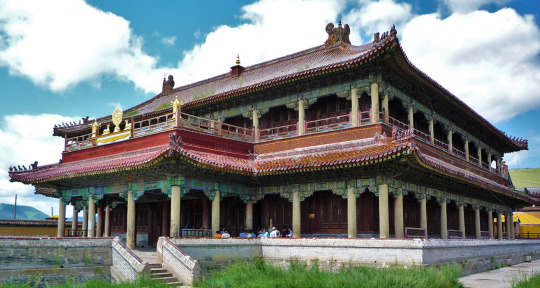
Experience the vastness of the Mongolian desert wilderness on a luxury road trip. Customized itineraries allow you to explore ancient monasteries, encounter nomadic herders, and marvel at the stunning landscapes of the Gobi Desert.
Luxury Holidays in Scotland:
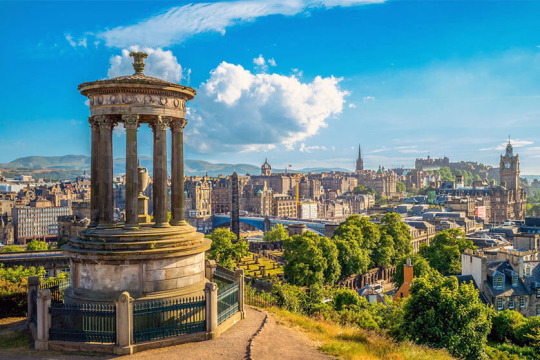
Wind through the picturesque countryside on a Self-Drive Tours in Scotland. Explore historic castles, quaint villages, and breathtaking lochs at your own pace, with road trip planners to guide you along the way.
New Zealand luxury road trip tours:
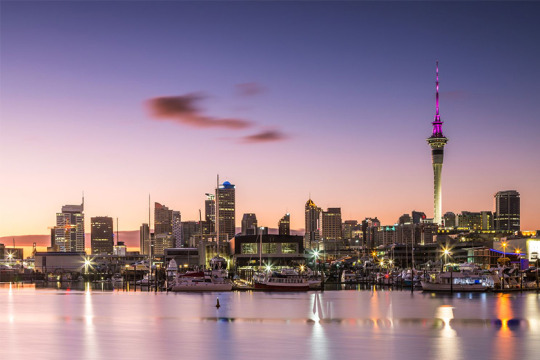
Discover the natural beauty of luxury New Zealand self-drive tours. From the stunning fjords of Milford Sound to the pristine beaches of the Coromandel Peninsula, New Zealand offers endless opportunities for exploration and adventure.
Namibia road trip adventure:
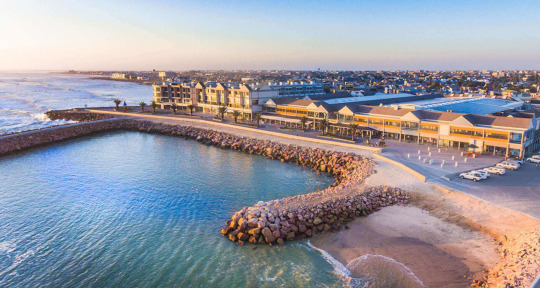
Navigate the otherworldly landscapes of Namibia Self-Drive Tours. Explore the towering sand dunes of Sossusvlei, encounter wildlife in Etosha National Park, and marvel at the ancient rock formations of Damaraland.
Finland Luxury Road Trips:
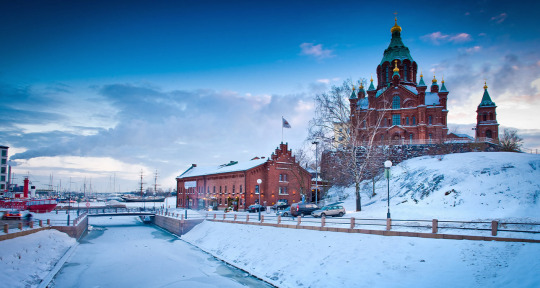
Immerse yourself in the natural wonders of Finland Self Drive Vacations. Journey through dense forests, tranquil lakes, and charming villages, with the opportunity to spot elusive wildlife such as bears and reindeer along the way.
Russia Road Trip:
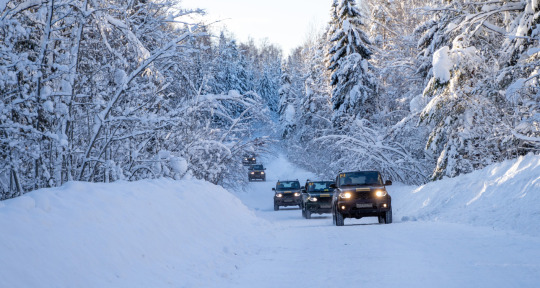
Embark on an epic road journey across Russia, from the historic streets of Moscow to the rugged landscapes of Siberia. Customize your Russia road trip route to include iconic landmarks such as the Kremlin, Lake Baikal, and the Trans-Siberian Railway.
Road Trips in Georgia:
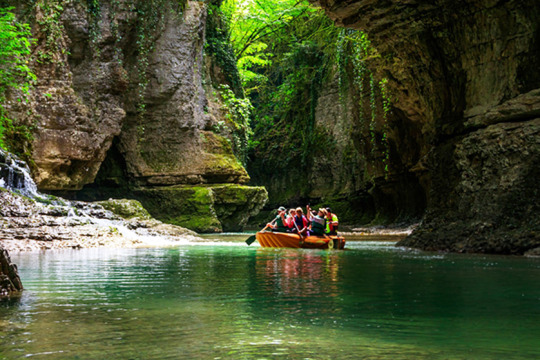
Discover the beauty and culture on a customized road trips in Georgia. Explore ancient churches, sample delicious cuisine, and soak in the stunning scenery of the Caucasus Mountains and the Black Sea coast.
Zanskar Road Trip:
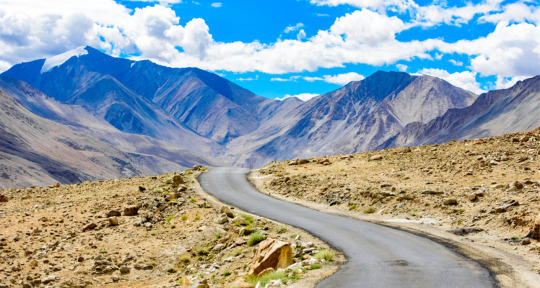
Journey to the region of luxury Zanskar road trip in the Indian Himalayas traverse winding mountain roads, visit ancient monasteries, and witness the breathtaking beauty of the Himalayan landscape.
Kashmir Road Trip:
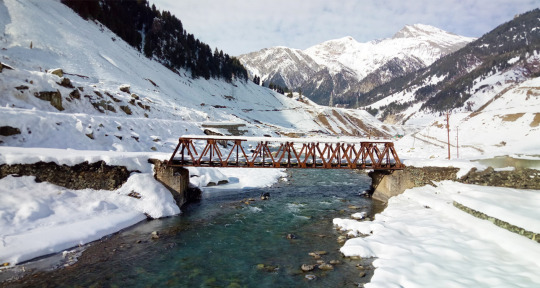
Explore the enchanting valleys of Kashmir Road trip adventure. Marvel at the snow-capped peaks of the Himalayas, cruise along serene lakes, and experience the rich cultural heritage of this scenic region.
Self-Driving Holidays Spain:
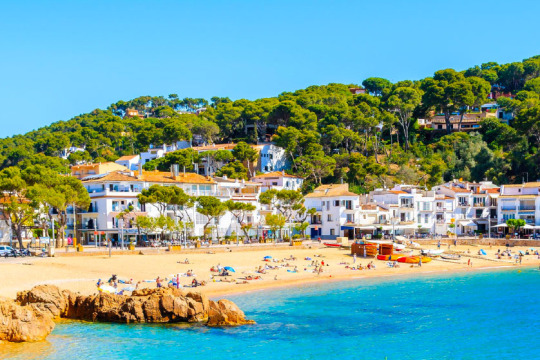
Discover the diverse landscapes and vibrant culture of Spain self-driving holiday. From the sun-drenched beaches of the Costa del Sol to the historic cities of Barcelona and Madrid, Spain offers endless opportunities for exploration and adventure on the open road.
No matter which destination you choose, a luxury road trip promises an unforgettable adventure filled with breathtaking scenery, cultural discoveries, and indulgent comforts. With the assistance of road trip planners, you can customize your itinerary to suit your preferences, ensuring a journey that is truly tailor-made for you.
#best road trips#road trip planners#customized road trips#luxury holidays in Scotland#Mongolia road trip#Namibia Self-Drive Tours#Best routes for a road trip in Namibia#Finland Luxury Road Trips#russia road trip#Kashmir road trip#Zanskar Valley self drive tour#customized road trips in Georgia
0 notes
Text
EPIC ADVENTURE ACROSS THE LAKE BAÏKAL
Some of my friends say I am living my dream. Some say I am living my passion. But it’s not as rosy as it looks. It’s not easy to travel on these adventurous expeditions while having an 11-year-old Autistic daughter at home. I am able to do these travels just because my one and only wife is supportive and allows me to follow my passion of adventure even though it’s difficult for her to manage without me. I will always stay indebted to her for this.
The same evening that I returned from the Mount Everest base camp expedition, I received a message from Venky regarding the Road to Baikal expedition in Siberia. In the morning, I had the permission granted and the confirmation went out to Venky and there was no looking back.
Expedition in this part of the world where the maximum temperatures are -10 degrees and minimum anywhere between -30 to -35 degrees required 100% preparation. Looking for appropriate clothing including sleeping bag, shoes, socks, etc. began. In the meantime the flight tickets were booked and the Russian visa was taken care off. Being in Russia and not visiting Moscow would be considered a crime. So, I decided to take a stopover at Moscow on my return journey.
Months passed by so quickly and before I knew it, I was on my way to Irkutsk in Siberia from Dubai via Moscow. The journey to Moscow was not so bad. But the 9-hour wait in the airport lounge was killing even though there was food and free drinks. Sitting all alone (only Indian) with no company was the worst part. I reached Irkutsk the following morning where I had to forward the clock by 5 hours. The representative of Nomadic Road, organisers of this expedition, transferred me to our hotel, The Courtyard by Marriott.
As usual Venky was at the reception to greet and welcome me. The temperature was a little disappointing. It was only -2 degrees whereas the average temperatures at this time of the year are above -10 degrees. The Adventure began the same day. We were booked in for a private helicopter tour on Lake Baikal to cover the south side where we wouldn’t be driving and a lunch to be served on the lakeside. After a quick breakfast and freshening up at the hotel, we assembled at the lobby by 12 pm. Also, met the guys who would be, partners in crime on this expedition. I knew Ashlyn (who has done 2 expeditions with me) and Ajesh as we are members of the same off-roading club in Dubai. Met Ram from Mumbai and Mittal my would be partner in the vehicle from Pune. Also met the brother in law duo of Vijay from Mumbai and Suresh from Cleveland, Ohio, USA. Another brother in law duo Neeraj from Delhi and Deepak from Mumbai were to reach later that night. Charles, the French filmmaker also would arrive later that night after missing his connecting flight to Irkutsk. Ram and Mittal were not taking the helicopter tour. So the 5 of us were transferred to the helipad, a half an hour drive from our hotel along with an English-speaking guide.
“Once a year, go someplace you’ve never been before”
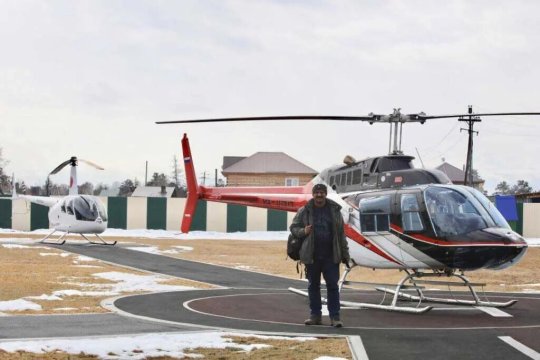
After a simple briefing, which was translated to us, we were on the choppers ready for take-off. I was paired with Vijay in a small chopper (due to weight issues) and the others were in a 6 seater. The ride took us above Irkutsk giving us a bird’s eye view of the city and following the frozen Angara River towards Lake Baikal. We were told to watch out for any wildlife below, but were not lucky enough to spot anything. We could also see the long Trans-Siberian railway line winding through the mountains.
The first view of the humongous frozen lake Baikal brought goose bumps all over. The magnanimity of the lake and the thought of driving on it for the next 7 days brought more excitement within.

At the first sight of the clear blue ice below, I almost screamed out of joy, but somehow contained it. The scenery below was out of the world and brought back memories of some good science fiction movies such as The snow creature. We also got to see some locals carrying out ice fishing, cars driving on the lake, a hovercraft and surprisingly an adventurer trying to cross the lake with a cycle. The experienced pilots took us as low as possible so that we could get a good look of the lake and easily landed the choppers on the lakeside at Polovinniy bay besides the railway track. This village at Polovinniy bay is abandoned during winters. By the time we walked along the railway line near the village, the pilots had set our lunch on the lakeside and surprised us with a bottle of champagne.

The lunch was a good spread of Fish and Beef along with the famous Omul Salad. Omul is a white fish species of the salmon family endemic to Lake Baikal. It is considered a delicacy in Siberia and eaten raw in a salad. As the champagne disappeared in a few minutes, Ajesh pulled out a bottle of Remy Martin from his bag. The Omul salad tasted great with the company of cognac and I had never imagined that I would be eating raw fish someday. Once done we took off again and flew over the town of Listvyanka where most of the tourist from Irkutsk comes to enjoy the frozen lake. It seems around 300 rivers come and empty themselves into lake Baikal and only 1 river flows out of lake Baikal which is river Angara and starts from Listvyanka.
We got to witness one more wonder of Mother Nature. The 700 meters at the mouth of the river Angara, where it flows out of Baikal never freezes under any circumstances and any temperature even in the harshest winters. The remainder of the journey was very scenic and kept me busy making video clips and clicking pictures. We also flew over the famous Taltsy museum, which is an open-air museum. Taltsy was a village of wooden houses, which was moved and preserved in the present location to enact the life of the Russians in the 17th and 18th century. It was on my list to visit this museum, but had to be satisfied by the aerial view due to shortage of time. Upon landing at the helipad, we celebrated our trip with local Baikal vodka shots at the heliport bar and returned to our hotel. In the evening Ram and Mittal joined me, Ajesh and Ashlyn for a walk to the old town. A picture by Babur the lioness, a bronze sculpture was a must. To read more visit - https://www.nomadicroad.com/stories/epic-adventure-across-the-lake-baikal
1 note
·
View note
Audio
(Baikal Nomads)
2 notes
·
View notes
Audio
(Baikal Nomads)
0 notes
Text
Thinkin about paleolithic nomadic hunter-gatherers settled by lake baikal during the fishing season and how they probably saw those funky seals just about every day.
Thinkin about the skeleton of an older woman who after a lifetime of weaving and mending hundreds of nets between her teeth had worn them through to the gum, and how every year she'd make the trek back, and see those funky seals, and know they'd made the journey.
#iirc they migrated to hunting land when the lake froze in winter but i forget the details#i just studied this individual in a class and it stuck w me
6 notes
·
View notes
Note

Is this basically what it looks like when an engine goes shopping? Or is it a more involved process?
That depends - for smaller machines this is basically accurate. The concept of a "drive thru store" was a very beneficial invention, and can be applied to vehicles ranging from automobiles all the way up to trains and small aircraft. Drive thru stores like this still usually employ attendants, but some movement has been made to automate the process in some countries - Japan being the most successful, with Lawson's markets unveiling a combination of automatic vending machines and programmable conveyor belts that dispense product without human interaction, an innovation that was later rolled out by their competitors. (Unsurprisingly, this has also proven to be a popular feature with Japan's human citizens as well.)

(This North American store caters mostly to humans, however it is also capable of serving small to mid-sized vehicles. Large ground vehicles such as over the road trucks and busses can be served in the parking lot by attendants.)
-
All that being said, serving individuals on a scale larger than that of railway locomotives is an incredible pain, and is done rarely outside of certain organizations and population groups:
Commercial airliners often joke that they still live in the 1960's, as the vast majority of their commerce takes place through mail-order catalogs, as few stores are capable of supporting them. Those stores that do support them are few and far between, usually operated by local airport authorities. Outside of those operations, family stores, usually set up during the early days of transcontinental flight or leftovers from World War Two, operate from a single location, with their clientele flying to them. Among the more notable stores includes Berlin's last remaining Intershop, which was built by the East German government along the Berlin Wall as a way to showcase their increased "machine rights" record, and survives today as the shop of choice for almost every Airbus ever made; Australia's Coober Pedy International Market, which features hangar lodging inside a disused opal mine (Which is more than capable of giving an A380 a claustrophobia-induced panic attack); and South Dakota's Wall Drug, which features a 19,000 foot dirt runway for airborne customers, a railroad spur and drive through operations for ground based craft, and a permanent 35% discount for any ship who manages to get to the store under their own power.
Commercial shipping works mostly off of mail-order catalogs as well as "mobile stores", where smaller ships or even helicopters make pre-arranged deliveries as well as offering goods for sale to anyone who can flag them down. While most of these operations are reputable, price gouging is known to occur, especially in less-reputable parts of the world. Some attempts have been made to create drive thru or otherwise land-based stores, but due to the nomadic nature of ships as well as their immense size, the concept has not caught on outside of captive ecosystems like the Suez and Panama Canals, Lake Baikal, and the Great Lakes.
That last point, however, does ignore one noted exception to the rule: the patient, diligent, and totally ignored staff of the United States Department of Defense's combined retail sales organizations.
The DoD's retail arms, which include: The Defence Commissary Agency, the Army & Air Force Exchange Agencies, and the Navy Exchange, do more work in the support for machine accessibility than the next ten organizations combined. They do it not because they want to, nor because they care - they do it because they have to.
The madate of these agencies is simple: serve the retail needs of the men and women of the United States military.
What is less simple is the fact that the "men and women" of the US Military are not just humans, but also Tanks, Humvees, Transport Aircraft, Jeeps, Trains, Hovercraft, Helicopters, Airships, Zeppelins, Trucks, Armored Personnel Carriers, NASA's Space Shuttle fleet, any retired vehicles who may have served the US Military in the past, and several hundred active duty warships ranging in size from 30-foot tugboats and Civil War era Ironclad ships all the way to Nimitz-Class aircraft carriers.
The logistical challenges these organizations face on an annual basis is so substantial that it often seen as hyperbole during annual budget appropriation hearings.
#ask response#ttte#sentient vehicle headcanon#headcanon#worldbuilding#sentient trains#sentient vehicles#background info
37 notes
·
View notes
Link
Excerpts from the above article:
The Grimaldi Goddess clay figurine, unearthed at the Neolithic settlement of Çatal Hüyük in Turkey, dates back to about 6000 BC. It depicts an obese woman giving birth while seated upon a throne. Although many have considered this a sure sign of feminine fertility, many scholars have dismissed the two massive dog-like beasts sitting by her side. The focus has continued being about sexual reproduction symbols, rather than her role in dog domestication and dominance over woman’s best and most loyal friend.
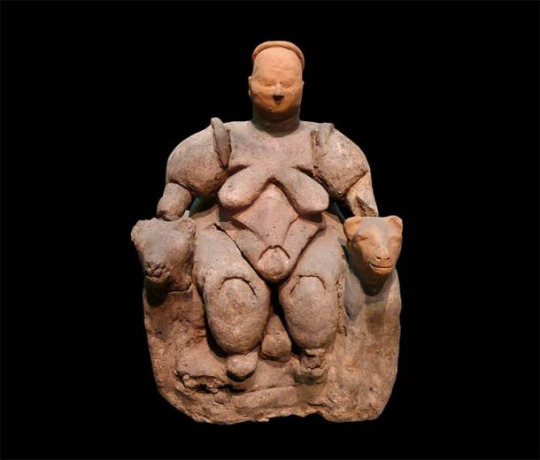
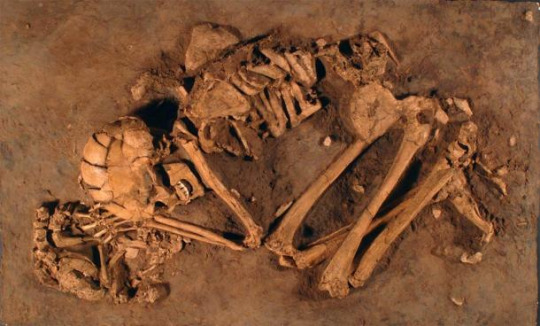
In northern Israel, archaeologists discovered the remains of a 12,000-year-old Natufian woman with her hand resting on a pet puppy, at the ‘Ain Mallaha site. This is one of the first known remains related to dog domestication. (The Israel Museum, Jerusalem )
At an excavation site near Lake Baikal in Siberia, the archaeologist and geneticist Andrea Waters Rist from Leiden University discovered two 8,000-year-old skeletal remains of Neolithic Siberian women carrying signs of the parasitic infection known as echinococcosis. This disease occurs when humans have long interaction and contact with canines through the sharing of food, water, and in some instances from being exposed to canine fecal matter. Waters-Rist’s analysis concludes that ancient Siberian women of this forgotten tribe might have been responsible for the caring, feeding, and rearing of dogs. Within every culture, there is distinct evidence that women were significant to the rearing and training of dogs. Shortly after the domestication of the dog, humans lived side by side with these animals, considered them equals, and depended on them for protection and assistance in their everyday lives. According to scholars such as Waters-Rist, it is therefore not surprising that humans would also endure the same sicknesses as well. As time went on, dogs were reared by both men and women, and they eventually became part of the family unit across many cultures. Without the friendship and alliance of dogs, there would be no human civilization. This fact must have been well understood in the ancient world, as there are several goddesses associated with dogs. Could these dog-friendly deities provide clues to the relationship between women and dogs?
Dog-Friendly Deities: Women and Dogs in Mythology
Aside from the Grimaldi Goddess figurine hypothesis previously mentioned, the list of gods who demonstrate a strong relationship with dogs include the goddess Gula, also known as Bau, Nintinugga, and Basat, who was often represented sitting near dogs. The goddess of dogs and healing, in her earliest form she was described as the dogs' controller, but she became associated with spells and healing in later years. Her temples were prevalent in Mesopotamia, Babylonia and Sumer, and stray dogs were allowed to roam within their walls. Altars at her temples were littered with dog statues, dedicated to her in the hope she would provide speedy recovery for loved ones. Her sacred symbol remained that of the dog until she was forgotten over time.
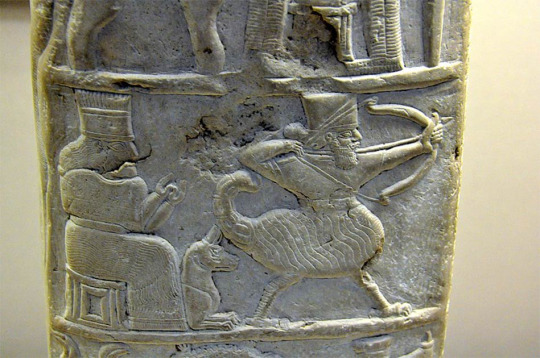

Left; Detail of the goddess Nintinugga, her dog, and a scorpion man from kudurru of Nebuchadnezzar granting Šitti-Marduk freedom from taxation. British Museum. ( CC BY-SA 4.0 ). Right Public Domain )
Other powerful mythical deities and goddesses were associated with hunting. The goddess Atalanta was often painted equipped with a bow, spear, and dogs, not to mention a severed boar head, representing luck with the hunt and fruitful prosperity. As the scholar Adrienne Mayor has mentioned, vase paintings depicted Amazon archers accompanied by dogs as they ran to battle or hunted. The eternal bond between women and dogs, especially on Greek vases, is evidence of an unbreakable connection. The goddess Artemis (Diana) is another deity which illustrates the connection between women, hunting and a feminine command over dogs, wolves, and animals. Another Greek goddess was Hecate, who was responsible for crossroads and entryways, as well as dogs. However, her depiction was far more sinister, as she represented the unpredictability of magic and spells. She was a shapeshifter, described as having three heads and was often responsible for dog barking, since they were obliged to announce her entrance anywhere she went.
Amongst the ancient Greeks, there are a few common themes related to women and dogs, in that their companionship was seen as old and mysterious, but beneficial for all. Much ancient Greek art portrays men hunting with hounds, but the representation of warrior women and ancient hunting deities could help shine a light on a past when women trained dogs for hunting and gathering.
There is not much evidence to speak for this hypothesis, besides some Greco-Roman art and a few Scythian warrior women gravesites with hounds. There is however significant evidence of women rearing and training dogs for the purpose of assisting in hunting and carrying supplies. The most extraordinary evidence can be seen with the ethnographic accounts of early North American Plains Indians as they spoke of the time before the arrival of Spanish horses.
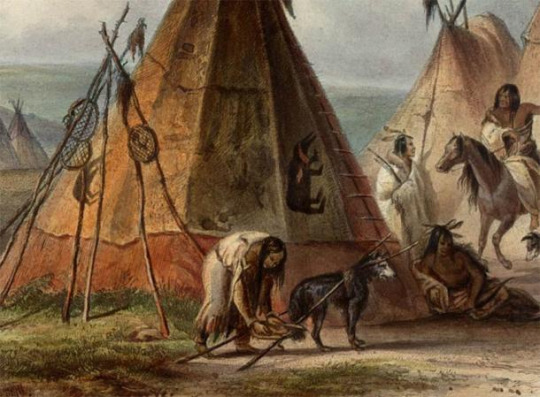
Detail from a Karl Bodmer painting showing a dog with a travois in an Assiniboine camp in the Great Plains. ( Public domain )
Women and Dogs in North American Plains Indian Culture
The most famous account is from the Hidatsa elder Buffalo Bird Woman. In her stories from the past, she discusses the older way of life for women and dogs within the American Plains culture. Her account explains that even after incorporating horses, it was only the more affluent families that could afford to house them. Most families still relied heavily on dog transportation by way of travois, two-pole sleds used by North American Plains Indians to carry goods, and their brutal nomadic way of life.
She states that women were considered the owners of dogs. They were expected to raise them, clean them, and train them. Like in many other cultures, the methods for domesticating dogs revealed a selection process over generations favoring the more complacent over the vicious and mercurial. The most favorable of puppies had large round faces, big legs, and floppy ears. These traits revealed a loyal and happy dog that would grow up big. Puppies that did not meet these criteria were often killed or given away.
Her narrative involves women training the dogs in hauling weights, in order to get an adult canine ready and able to carry between 50 and 70 pounds (22 to 32 kilos) by travois. Once this task was completed, the dog would be used for multiple purposes. In some situations, anywhere from 20 to 70 dogs would be brought on hunts and expected to carry the processed buffalo meat back to camp without being tempted to eat any of it. Women would also take packs of between 12 and 20 dogs to collect firewood and supplies to sustain their families one month at a time. With every task given, it was still customary for a woman to care and equip the dogs, as well as ensure they were comfortable in their tasks.
According to Buffalo Bird Woman’s account, dogs would always follow in single file behind their women owners, and if any of the dogs tired, the women would know how to keep them encouraged. In the summer, women knew not to load dogs as heavily as in winter. This had to do with the heat and the friction from the ground. During winter, the weather and snow worked in a travois-pulling dog’s favor. It was also necessary for women to continue keeping the dogs hydrated throughout the day, for they were always in use.
#hekate#wolf domestication#feminist witch#goddess worship#canine domestication#atalanta#artemis#diana#women's history
205 notes
·
View notes
Text
Baron Roman Ungern von Sternberg, The Man Who Would Be Mongolian Emperor
New Post has been published on https://china-underground.com/2016/04/11/baron-roman-ungern-von-sternberg-man-mongolian-emperor/
Baron Roman Ungern von Sternberg, The Man Who Would Be Mongolian Emperor
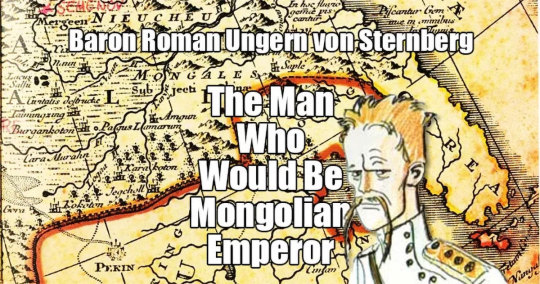
Baron Roman Ungern von Sternberg (Roman Fedorovich Ungern von Shternberg), also known by the epithet Mad Baron (or Black Baron; January 22, 1886, September 15, 1921), fought the White Movement during the Russian Civil War and later was a bloodthirsty warlord.
He attempted to establish a monarchy in Mongolia and the lands to the east of Lake Baikal.
Related article: Haunting images of Mongolia (1913), Japanese war prints of the Sino-Japanese war, Fascinating Xinhai Revolution images, the Chinese Revolution of 1911, history of the First Sino-Japanese War

He was born in Graz, Austria by a Balkan family and grew up in Tallinn in Estonia, which at the time was not yet entered in the orbit of Russia, in the custody of his stepfather Oscar von Hoyningen-Huene.
After attending the Pavlovsk Military Academy in St. Petersburg, he served in Siberia where he came in contact with the nomadic lifestyle of Mongolian and Buryat tribes. During World War II, Ungern von Sternberg fought in Galicia.
In this period he was considered a brave soldier, but sometimes reckless and unstable. General Wrangel mentioned in his memoirs fears to promote Ungern-Sternberg.
After the February Revolution of 1917, he was sent by the provincial government in Eastern Russia, under the command of Grigori Semenov to establish a military garrison.
With the October Revolution of 1917, Semenov and his right arm, Ungern von Sternberg opposed the Bolsheviks.
In the following months, Ungern von Sternberg distinguished himself for his cruelty towards the local population and his own subordinates, earning the nickname Bloody Baron. For his decidedly eccentric attitudes, it was also called Crazy Baron.
Semenov and Ungern von Sternberg, though anti-Bolsheviks, were not part of the White Movement and did not recognize the authority of Admiral Aleksandr Kolchak.
They were instead supported both financially and from a military point of view by the Japanese. The Japanese hoped to set up a puppet state headed by Semenov in Eastern Russia. For Kolchak who believed in Russia as a powerful and indivisible entity, this was an act of treason.
The troops of Ungern von Sternberg were a mixture of Russian soldiers, Cossacks, and Buryat nomad’s ethnicity. They targeted the supply trains of the Bolsheviks and of the White movement.
Semenov and Ungern von Sternberg were successful against the White Movement as the base of operations of Admiral Kolchak was located in the heart of Central Siberia and the trains came from Vladivostok, on the Pacific Ocean.
At this point, the railway line of the Trans-Siberian was in their hands. But they chose different paths in 1920 when Ungern decided to become a Lord of the Independent War.
He strongly believed that the monarchy was the only antidote to the corruption and self-destruction of Western civilization. He began to cultivate the idea of restoring the Qing Dynasty of China on the throne and then unifying the countries of the Far East under its flag.
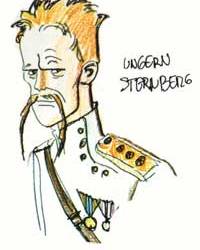
It was also a fanatical anti-Semitic leader and in 1918 he proclaimed to want to exterminate all the Jews and the Russian Communists bringing back the Grand Duke Mikhail, the younger brother of Nicholas II on the Russian throne. Its troops massacred many Jews fleeing even with extremely cruel ways as flaying victims still alive. Since 1919 Mongolia was under the control of the Republic of China forces.
At the turn of 1920 and 1921, the troops of Ungern von Sternberg entered Mongolia called by the deposed Bogd Khan, a civil and religious Mongol leader.
In January 1921 the army of Ungern repeatedly assaulted the capital Urga (now Ulaanbaatar), but without ever succeeding and undergoing numerous losses. He gave orders to set fire to the fields around the city trying to tighten its grip on the besieged. The following February he managed to take control of the city.
On 13 March 1921 Mongolia was proclaimed an independent monarchy, and Ungern von Sternberg became its dictator.
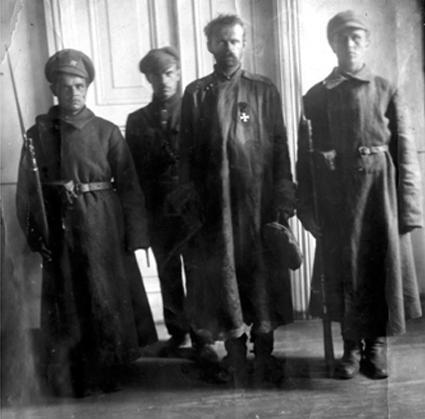
Baron Roman von Ungern-Sternberg before being executed.
Ungern was a mystic fascinated by Eastern religions that believed to be the reincarnation of Genghis Khan and the XIII Dalai Lama: an abnormal mixture of Russian nationalism and Chinese and Mongol beliefs.
His brief reign was characterized by looting and terror.
A Red Army sent to fight Ungern, supported by the leading Mongolian pro-Soviet Shbaatar (Sukhe-Bator), defeated the Mad Baron troops.
In May Ungern von Sternberg tried to invade the territory of Russia at Troitskosavsk (now Kyakhta, Buryatia).
After some initial successes in May and June, in the summer he was defeated by the Soviet counteroffensive and was arrested on August 21, 1921. After a summary trial, he was executed in Novonikolayevsk (Novosibirsk today).
Before being shot, he swallowed his St. George Cross medal of honor, to prevent it from falling into communist hands.
Curiosity
Ungern von Sternberg is at the center of the beautiful graphic novel by Hugo Pratt “Corte Sconta detta Arcana” (Corto Maltese in Siberia), first serialized in the Italian comics magazine Linus in 1974, where he will meet Corto Maltese.
In the video game Iron Storm, Ungern becomes the model to depict the evil “Baron Ugenberg”, the leader of a mysterious Russian-Mongolian Empire during the First World War until the early sixties.
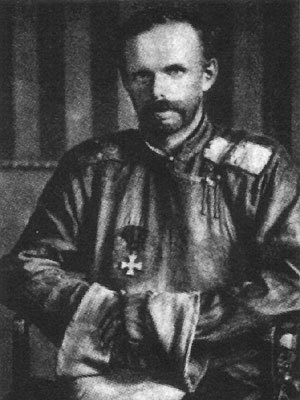
Source: Wikipedia, CinaOggi.it Drawings from Corto Maltese in Siberia, Hugo Pratt, 1974
#Communism, #CortoMaltese, #GengisKhan, #History, #HugoPratt, #MadBaron, #Mongolia, #MongolianEmpire, #QingDynasty, #UngernVonSternberg, #WhiteMovement
#communism#corto maltese#gengis khan#history#hugo pratt#mad baron#mongolia#mongolian empire#Qing Dynasty#Ungern von Sternberg#white movement
3 notes
·
View notes
Text
Globally in the Continuation-verse:
The Earth Kingdom and Emperor Puy-er King Kuei are shitting blood at the thought of a Russian Revolution scenario in the Fire Nation (or worse the Committee of State Emergency ensuring a 1933 Hitlerian scenario of the 'again but worse' gang taking over intent on World War II). After all, the Fire Nation monarchy is much more popular in its own domestic sense than his is, so he's preparing to go full Prussia-Russia-Britain if the Revolution overthrows the monarchy, and full Stalin if the Nazi equivalents do.
The Water Tribes are just as nervous and militarizing into full-fledged naval great powers because the prospect of either faction winning besides the devils they know is something they have good reasons to fear in either case (the People's Will would treat them about the way the Bolsheviks did Central Asians and the Baikal Mongols, aka 'target practice is the good day and there's all manner of efficiently horrible bad ones. The Committee would intend to finish what Azulon began in the South and then turn on the North next).
The Air Nomads, all two of them, really don't like any of this but the Avatar can't exactly Avatar State away a revolution caused by centuries of pressure cooker conditions coming home to roost when his intervention set the trainwreck in motion.
Autocracy is not a healthy system, it's not viable in a longer-term sense, and if it loses a war and has a man too strong to allow others to rule but too weak to stack up the pyramids of skulls needed to make autocracy function in finest style, that's how you get Tsar Nicholased.
Ironically due to her being officially dead for 11 years, Azula's sudden survival and being brought into the public eye entirely unwillingly is an Outside Context Problem none of the schemers actually anticipated....except the People's Will, who realize entirely well that she is there unwillingly and now ol' Vladimir Len-er Mo Ce can play a new game with much more unpleasant sweepstakes.
While Gennady Yennadey-er Eye and Ear of the Fire Lord Jamuquah has his own schemes in motion, assured that the Princess is in the perfect place to announce the restoration of the Old Order and the renewal of the great war she so willingly fought and was so efficient in leading.
#atla continuation verse au#fire nation started off imperial japan#now it's tsarist russia#not sure if this is an upgrade or a downgrade#the other nations certainly see it as a downgrade
4 notes
·
View notes
Photo


Baikal - Trait Poitevin Mulassier
The Pixel Nomad & Vor-die-Linse • Fotografie
154 notes
·
View notes
Photo

The most non-Slavic Cossacks: who are they The question of the ethnic component of the Cossacks still causes a lot of controversy. One thing is clear that the Cossacks are heterogeneous in their national composition. It all depends on where and how this or that class was formed.
In historical circles, there were two theories of the origin of the Cossacks – migration and autochthonous. The first suggests that the Cossacks were formed as a result of the migration of representatives of Slavic peoples, mainly Russians and Ukrainians, to the southern and Eastern regions of Russia. The second insists that the Cossacks are an aboriginal people from the upper don.
Soviet anthropologist Viktor Bunak considered the Cossacks to be descendants of immigrants from the East Slavic territories, who, constantly mixing with each other, formed a largely artificial class of colonization type. According to Bunak, this class is closest to the Russian and little Russian ethnos anthropologically.
The autochthonous version was defended by scientists Gottlieb Bayer and Vasily Tatishchev, considering the Cossacks to be an independent, different people from the Russians. Tatishchev, in particular, pointed out the connection of the Cossacks with the Circassians. A more balanced ethnic characteristic of the Cossacks was given by the Brockhaus-Efron encyclopedic dictionary.
It noted that " the Cossacks do not represent any separate type, belonging partly to the great Russians, partly to the little Russians, with more or less admixture of the blood of the aborigines on whose lands they settled."
The point of view expressed in the encyclopedia is now supported by most scientists. Due to the established traditions, the Cossacks throughout the entire period of their history were largely multi-ethnic in their composition. It is well known that the Khutor community could assign a person of any nationality to the Cossacks. His descendants, gradually assimilating into the Cossack environment, were already considered full-fledged members of the Cossack class.
For example, in the tsarist Russia in the Siberian Cossack army in addition to the Russian there were 6% of Ukrainians, 5% of Mordovians, 3% of Belarusians, 1% of Tatars, there were also Chuvash, Perm, Cheremis, Zyryans. The Ural Cossack army consisted of about six thousand Bashkirs and one thousand Kalmyks, and about 400 Chinese were assigned to the Semirechensk Cossacks.
Perhaps the most famous Cossack-Slavic roots can be called legendary Buryat Dandaka Irincheeva. This TRANS-Baikal Cossack was a guide, translator and faithful companion of Nikolai Przhevalsky, accompanying the famous traveler in all his expeditions.
The heterogeneity of the Cossacks was provided not only by its international composition, but also such phenomena as cross-breeding. Researchers describing the Cossacks as closely related to the Kyrgyz region even had to introduce such a concept as"a special regional ethnographic type".
The famous ethnographer of the beginning of the XX century A. N. Sidelnikov drew attention to the fact that it is difficult to establish who was the founder of a particular Cossack family. According to him, the first colonists – Russians, Ukrainians, poles – entered into close relations with the Tatars, Kirghiz, Kalmyks and other peoples, which resulted not only in mestizoism, but also in a change of lifestyle, habits and morals.
Among the most striking examples of mestizoism are the distinctly Asian features of one of the leaders of the White movement, Lavr Kornilov, who was born to a retired cornet, a Russian by nationality, and a Kazakh woman from a nomadic family.
The don Cossacks, in contrast to the TRANS-Ural Cossacks, almost did not undergo metisation. It is not surprising that the vast majority of them consider themselves to be of the Russian ethnic group. Not so long ago, employees of the Federal institution "Medical and genetic research center" studied residents of native Cossack villages on the don (131 men), whose ancestors lived in this region until the third generation. The purpose of the study is to trace their genetic lineage.
The results of the experiment showed that the ancestors of all the subjects were more genetically related to the population of the southern regions of Russia, slightly less similar to the inhabitants of the Central regions of Russia, and a certain contribution was found from the Turkic-speaking populations. The latter is most likely due to the presence of the Nogai layer in the don Cossacks. Scientists also determined that the don and Kuban Cossacks have no genetic relationship with the Caucasian peoples.
Unlike the don and Kuban Cossacks, the Terek Cossacks include in their gene pool a significant number of Y-chromosomes peculiar to the indigenous population of the Caucasus, said Oleg Balanovsky, head of the genomic geography laboratory At the Institute of General genetics of the Russian Academy of Sciences. Haplogroup g was common to the Caucasians and Terek Cossacks.
According to the scientist, the Terek Cossacks were the first Cossack community formed on the border between the steppe and mountain peoples. If the Kuban and don Cossacks were replenished mainly by immigrants from the interior of Russia and Ukraine, then it was different with the Terek Cossacks. They lived in peace with the mountain peoples for quite a long time, which favored the formation of inter-ethnic marriages. In the end, as Balanovsky writes, the Terek Cossacks absorbed more than a quarter of the local, autochthonous Caucasian haplotypes.
3 notes
·
View notes
Text
Siberian History (Part 7): Mangazeya
The Russian frontiersmen in Siberia still had to depend on Moscow for support (such as administrative & logistical support). During the Time of Troubles, the Siberian garrison was mostly left to themselves, which lead to disease, starvation and death.
The natives peoples of Siberia took the opportunity to make several attempts at an uprising. The most powerful was in 1608, when Princess Anna of Koda, a “Tartar Joan of Arc”, nearly succeeded in uniting the entire native population of Western Siberia to revolt.
In 1612, an attempt was made to re-establish the old Khanate of Sibir “as it had been in the time of Kuchum”. But it was betrayed at the last minute, and ten of its ringleaders were rounded up and hanged.
By now, the Russian occupation of the Ob-Irtysh Basin had increased the nation's size by a third. But in Moscow, Siberia still wasn't properly understood as a geographical entity, and so it was used as a political bargaining chip.
Boris Godunov, for example, tried get an influential boyar to support him against False Dmitry I, by promisng him “the Kingdoms of Kazan, Astrakhan, and all Siberia”. The False Dmitry II promised to reward his brother-in-law, a powerful Polish noble, with “the whole land of Siberia” for his help.
But the Ob-Irtysh Basin had scarcely been secured before the Russian advance into the next great river valley, the Yenisei, began.


The Russians ascended the eastern tributaries of the Ob River, and crossed a low plateau to streams flowing into the Yenisei. By 1619, they had taken all the important river routes and portages that connected those two rivers. They organized expeditions from Mangazeya (in the north) and Tomsk & Ketsk (in the south), coming at the river valley from both directions.
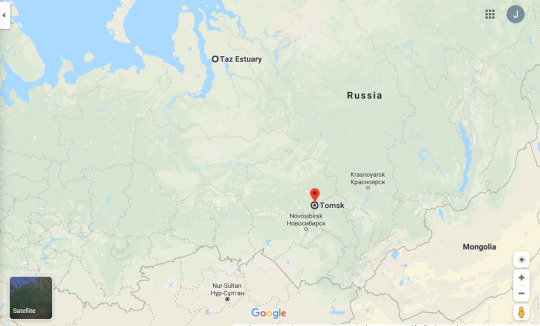
The Taz Estuary marks the area where Mangazeya was located.
They met the Tungu people on the lower Yenisei, and the Buryats (whom they'd never heard of before) on the upper Yenisei. The Buryats lived in a region that was rich in furs, and they practised animal husbandry; they were rumoured to grow crops and have access to silver. This was guaranteed to interest Russia.
The Tungu people (east of the Yenisei) and the Buryats (around Lake Baikal) fought to prevent Russia from establishing bases in their territory, but failed. Yeniseysk was founded in 1619 (where the Angara and Yenisei Rivers meet); Krasnoyarsk was founded in 1627 (astride cliffs of red-coloured marl); and Bratsk was founded in 1631 (on the Angara River).

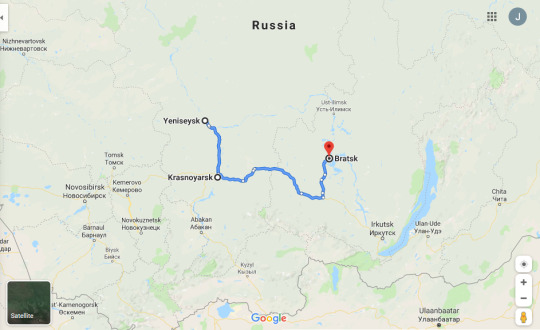
On the upper Yenisei River (the southern part of it), the Russians met the staunch resistance of the Kyrgyz people and the Kalmuks, both steppe nomads. Their homelands bordered Siberia to the south, and they were continually hostile. Eventually, a solidly-fortified line was established over the southern frontier, but this would take two centuries.
Meanwhile, Russian mariners had developed the sea route north of Russia from Arkhangel to Mangazeya (which was just a few miles above the Arctic Circle). At Mangazeya, they bartered goods with the local Khanty and Samoyedic peoples for furs. Mangazeya prospered and grew, attracting more and more traders, who were willing to navigate the treacherous waters of the Kara Sea.
One contemporary account says that: “Hundreds of thousands of sable, ermine, silver and blue fox skins, and countless tons of precious mammoth and walrus ivory” were shipped every year from Mangazeya and Europe. This was an illicit trade that had begun during the Time of Troubles, and the government couldn't manage to gain control of it.
Porcelain, silk, and other expensive fabrics were traded (through middlemen) from Central Asia & China to Mangazeya. The city was “a virtual Baghdad of Siberia, where big commercial deals were celebrated at fabulous feasts that lasted for days, and that featured the best European wines and local delicacies like sturgeon, caviar, mushrooms, berries, and venison and other game.”
By the time stability was restored in Moscow, reports of Siberia's vast wealth in furs had spread far and wide. This, of course, attracted the attention and greed of European powers who wanted new colonies. The Russian government worried that foreign agents might try to trade directly with the natives, or even attempt an armed invasion (through the Taz Estuary) to seize the whole of north-western Siberia.
Meanwhile, inland merchants working out of the Urals, Tyumen and Tobolsk were envious of Mangazeya, as it siphoned off commerce that would otherwise have come to them.
So in 1619, the Russian government closed the sea route to Mangazeya. They forbade even Russians to use it, in case foreigners found it out from them. Anyone who broke this law was to be “put to the hardest possible death, and all their homes and families destroyed branch and root”.
Navigational markings were torn up. Surveillance posts were established along the coast, to intercept and kill anyone who tried to get through. A coastal fort was built on the Yamal Peninsula, commanding the portage between the Ob Gulf and the Kara Sea. Maps were falsified to depict Novaya Zemlya as a peninsula, rather than an island. This would cause problems for later mariners who were using them as nautical guides.
Gradually, Mangazeya declined, and the rich merchants left. In 1643, its administrative apparatus was moved to Turukhansk – this city was founded at the mouth of the Turukhan River, a tributary of the Yenisei. For a while, it was known as “New Mangazeya”.
In 1678, Mangazeya was burned to the ground, without any official explanation. The local Samoyedic peoples called its ruins Tagarevyhard, which means “destroyed town”. The site wouldn't be rediscovered for almost three centuries.
Mangazeya, perhaps more than any other early settlement, was the proof of the enormous wealth that Siberia possessed. In 1632, a former military governor of the district strongly encouraged the tsar to press on from the Yenisei to conquer the Lena River Basin. His encouragement was inspired by the riches of Mangazeya.
#book: east of the sun#history#military history#colonialism#economics#trade#native siberians#tungu people#buryats#kyrgyz people#kalmuks#khanty people#russia#khanate of sibir#siberia#yeniseysk#krasnoyarsk#bratsk#mangazeya#turukhansk#boris godunov#false dmitry ii
36 notes
·
View notes